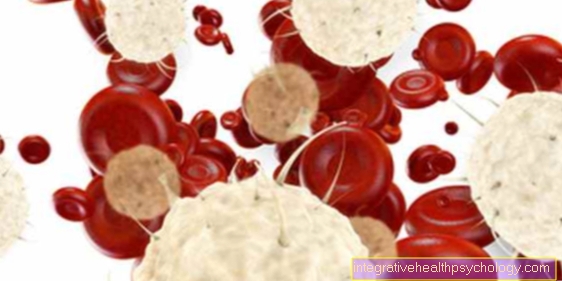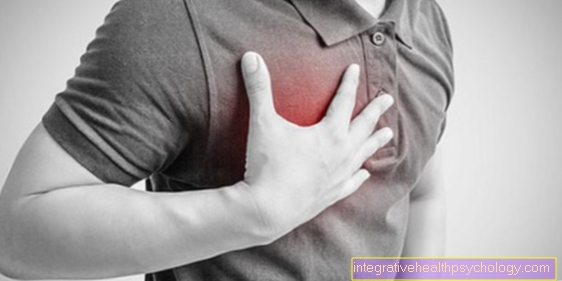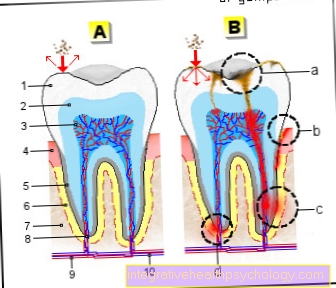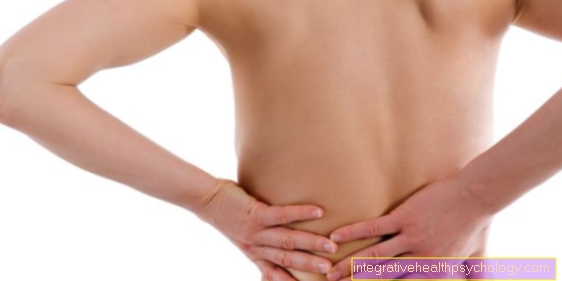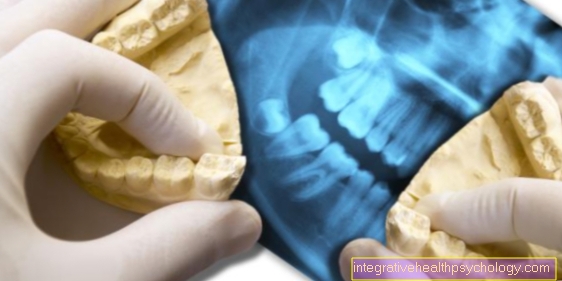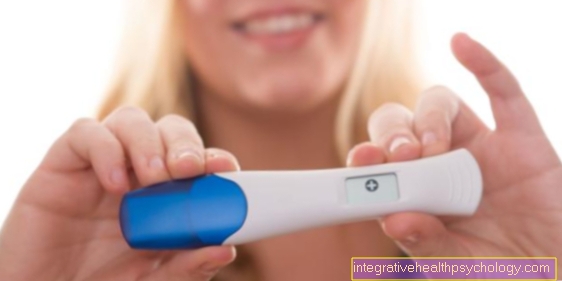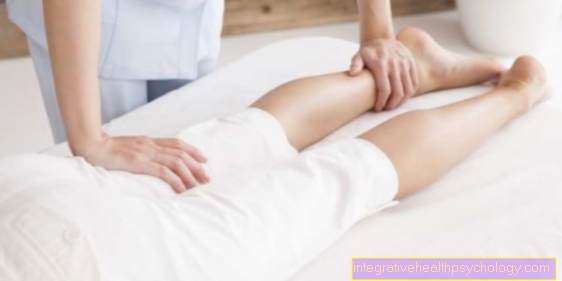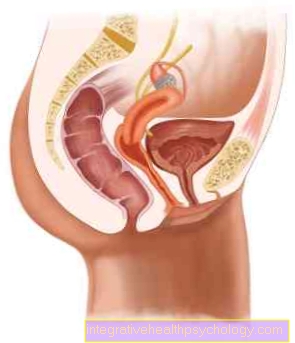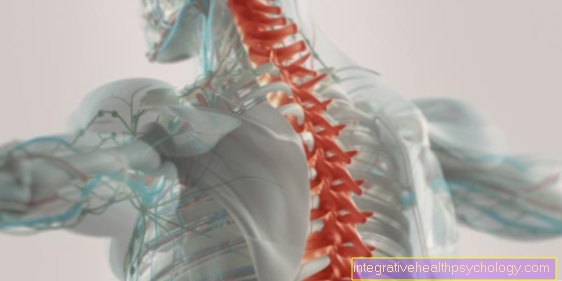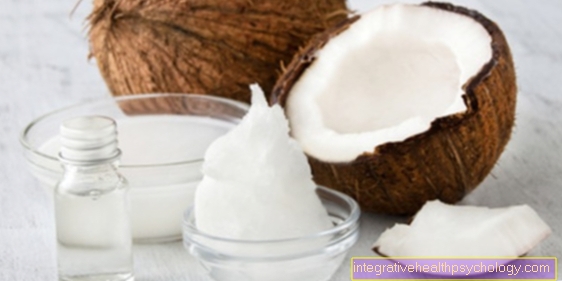Cramps in the upper abdomen
introduction
Spasmodic pain in the upper abdomen can indicate a variety of disorders and diseases. A distinction is made between acute and chronic pain conditions. Cramps in the upper abdomen can be triggered, for example, by intolerance, nutritional errors, allergies, inflammation, functional problems and by malignant changes in organs.
The pain is often perceived in a particular place, but the cause of the pain does not always have to lie directly in the organs of the abdominal cavity. Pain in neighboring organs such as the diaphragm, the urogenital tract or the spine can also manifest as cramps in the upper abdomen.
In children, causes such as a bad stomach, tooth growth or various psychological fears are in the foreground when they suffer from cramps in the upper abdomen.
In the upper abdomen there are various organs, in addition to the digestive organs, stomach, intestines, gall bladder and pancreas, the liver, spleen, blood vessels, lymphatic systems and kidneys are located there, all of which can cause cramps in the upper abdomen.
Diabetes (Diabetes mellitus) can lead to so-called pseudoperitonitis in the event of a derailment of the blood sugar level, which manifests itself in severe epigastric cramps and severe nausea. The same symptoms can also cause other metabolic disorders, which must be treated as an emergency. During pregnancy, too, there are occasional cramps in the upper abdomen, whereby harmless growth problems must be differentiated from serious complications.
General information about abdominal cramps can be found at: Cramps in the abdomen

causes
The majority of all abdominal pain or cramps in the upper abdomen are relatively harmless, non-life-threatening in nature and are caused by a bad stomach, poor nutrition, an infectious bowel inflammation (Enteritis) or a lack of digestive juices (dyspepsia) caused.
Stomach diseases are very often the cause of cramps in the upper abdomen, for example due to an inflammation of the stomach lining, an irritable stomach, heartburn or a stomach ulcer. Even with constipation, pain or cramps in the upper abdomen can quickly occur.
This can often be relieved by making small changes in eating habits (e.g. increasing the consumption of vegetables) and drinking enough. Another harmless cause of cramps in the upper abdomen are side stitches, which occur mainly during prolonged physical exertion.
An inflammation of the peritoneum (peritonitis) can also cause cramps in the upper abdomen, which usually results in a very tense and tender abdominal wall. Pneumonia or pleurisy can also lead to upper abdominal discomfort, although these are typical diseases of the chest cavity.
Pain originating from the heart or the coronary arteries (e.g. heart attack, angina pectoris in coronary artery disease) is also very often felt in the upper abdomen. Likewise, inflammation or other diseases of the pancreas can manifest themselves as cramps in the upper abdomen.
A wall tear is an emergency situation (Dissection) the main artery, which manifests itself in severe chest pain and upper abdominal pain, possibly also in circulatory shock.
Biliary colic
Cramps in the upper abdomen usually arise from a pathological change in the liver and bile. If the cramps are to be understood in the sense of strong, wave-like pain, one speaks of biliary colic. The term colic itself describes the most severe pain caused by spasms in the muscle cells of hollow organs.
In this case, these hollow organs are the gallbladder and its ducts. The symptoms of biliary colic are most often caused by inflammation of the gallbladder (Cholecystitis) or gallstone disease (Cholelithiasis). If such a stone obstructs the bile duct that leads to the intestine and this duct becomes inflamed, it is called biliary inflammation (Cholangitis).
Concomitant symptoms
In general and regardless of where exactly the inflammation takes place, those affected complain of pain on the right side of the upper abdomen with nausea, vomiting, flatulence and a feeling of fullness. Often these pains are also dependent on meals. The inflamed gall bladder is particularly noticeable after high-fat meals.
Biliary colic is characterized by the fact that the pain is typically projected into the right shoulder region (this complicated mechanism takes place in the spinal cord. The right shoulder as the projection site is the head zone of the gallbladder). In general, the painful cramps can radiate into the stomach area and back.
If the gallbladder becomes inflamed without the ducts involved, fever and other alarming symptoms, such as blood poisoning, also occur. Since it is based on a stone that tends to be larger and cannot leave the gallbladder, there is a very specific pain point in the right upper abdomen that can also be provoked (Murphy's sign, see: Diagnosis of gallbladder inflammation).
This is not the case with gallstone disease of the ducts (Choledocholithiasis). Although the painful cramps are also strong and wavy, the pressure pain is rather diffuse, but most likely belt-shaped. If a gallstone obstructs the bile duct in such a way that the bile can no longer drain into the intestine, so-called jaundice occurs (Jaundice).
The skin and conjunctiva of the eyes turn yellow, those affected complain of itching of the skin and notice a discolored stool and at the same time dark urine (most likely rust-red, brownish). If the bile ducts are inflamed (Cholangitis) the above complaints are also present, only in combination.
In general, bilious colic sufferers are plagued by pain, their appetite is reduced and their performance is poor. Depending on the complications, symptoms of blood poisoning may also occur (sepsis) come.
Duration
In the mild form, symptoms are mainly found after meals without any further symptoms. These then decrease between meals. In the case of more severe and acute forms, only a lack of food brings a slight improvement in the symptoms. The cramps only disappear after adequate antibiotic and / or surgical therapy.
forecast
The prognosis depends on the risk factors and the course of the respective genesis. If someone has all the risk factors for gallstone disease (overweight, female, of fertile age, under 40 years of age, fair-skinned complexion, diseased family members) the probability of a relapse (recurrence of the stones) is high.
In general, it is also true that half of all those affected with biliary colic develop new colic within a year.
Therapy - what to do with cramps in the upper abdomen?
In the case of acute abdominal pain or cramps in particular, it is often necessary to distinguish between harmless causes and diseases that require immediate treatment. Especially if there are additional symptoms such as nausea, vomiting, circulatory symptoms or fever, there can be a variety of diseases in different parts of the body, which must be followed by an (emergency) medical examination and possibly even a hospital admission.
Since cramps in the upper abdomen are relatively harmless in nature in many cases, simple measures can often alleviate the symptoms. Local application of heat through a hot water bottle, a grain pillow or a warm bath often relieve cramps in the upper abdomen.
Warmth from drinking warm tea is also often helpful. The use of painkillers should be handled with caution if the cause of the cramps is unclear, as painkillers can make the symptoms worse in certain situations.
A common example of this is inflammation of the stomach lining, in which the cramps in the upper abdomen are made worse by drugs such as aspirin or ibuprofen.
If diseases of the internal organs are the cause of the upper abdominal cramps, the treatment depends on the respective diagnosis. In any case, in the event of unclear, persistent complaints, a doctor should be consulted in order to safely rule out serious illnesses.
After localization of the cramps
Cramps on the right side of the upper abdomen
The exact description of the localization of cramps and pain in the upper abdomen often provides initial clues as to the cause of the symptoms. The liver occupies a large place in the upper right abdomen and the gallbladder is also located here. Inflammation of the liver (hepatitis) or the gall bladder, as well as other diseases of these organs, can lead to cramps in the upper abdomen.
So-called biliary colic, which is triggered by gallstones, is particularly common. This leads to persistent strong cramps that radiate into the right shoulder and may be associated with nausea, nausea, sweating or jaundice (jaundice).
Spasmodic pain in the right upper abdomen can also be triggered by appendicitis. The appendix is usually located in the lower right abdomen, but if there is inflammation, pain can also be felt in the upper abdomen.
Spasms in the left upper abdomen
The spleen is located on the left in the upper abdomen. Various diseases of this organ can lead to pain or cramps in the left upper abdomen and radiate into the left shoulder. An infection or an abscess in the spleen can lead to a strong enlargement of the organ, which causes discomfort.
Acute left-sided epigastric cramps may indicate a splenic infarction.
The left kidney can also cause cramps in the left upper abdomen due to inflammation or other causes, which are often also felt in the left back area. But complaints from the pancreas or the stomach can also be felt on the left side. For example, diseases such as inflammation of the esophagus, inflammation of the stomach or inflammation of the pancreas, especially on the left, lead to cramp-like pain.
Cramps in the middle of the upper abdomen
If the cramps in the upper abdomen are mainly localized in the middle, the symptoms usually originate in the stomach.Heartburn is when acidic gastric juice runs back down the esophagus, which can be very painful and can also lead to cramps.
Also with an irritable stomach syndrome or an inflammation of the stomach lining (gastritis), cramps in the upper abdomen can occur. Diseases of the pancreas, but also gallstones or diseases of the gallbladder, are also often felt in the middle of the upper abdomen. Inflammation of the pancreas is most commonly caused by chronic alcohol consumption and usually manifests itself as cutting, burning, cramp-like pain in the middle of the upper abdomen.
Upper abdominal cramps can be part of labor
In the case of abdominal pain and cramps in the upper abdomen, it is often difficult for mothers-to-be to tell whether the symptoms are pregnancy-related or real labor. From around the beginning of the second half of pregnancy, pregnant women regularly go into labor pains.
The uterine muscles contract at irregular intervals and the abdomen becomes hard as "training" for childbirth. Usually the contractions are not painful and only last a short time. Pre-contractions occur from the 36th week of pregnancy, which can also be perceived as cramp-like, but painless upper abdomen pulling.
Real labor is manifested by cramps in the upper abdomen, which occur regularly and at shorter intervals. In addition, the pain associated with them gradually increases. If real contractions occur before the 36th week of pregnancy, possibly associated with back pain or watery or bloody discharge, a doctor should be consulted immediately. In principle, if it is unclear whether cramps in the upper abdomen during pregnancy are contractions, the advice of a midwife or doctor should be sought.
Upper abdominal cramps during pregnancy
Pregnancy is associated with increasing stress on the body, which is why almost every pregnancy leads to more or less severe abdominal pain. In some cases the symptoms escalate to real cramps, mainly caused by the baby's growth. Also Practice pre-labor and real labor can make themselves felt through discomfort in the upper abdomen. Acute, milder epigastric cramps, which are normal side effects of pregnancy, can be treated with warmth, rest and relaxation.
In the early pregnancy can become a Miscarriage or Ectopic pregnancy by Bleeding and cramping pain express. Medical assistance is necessary in both cases. Late miscarriage in the second trimester of pregnancy is also associated with bleeding and severe and painful cramps. If you experience symptoms like this, you should see a doctor immediately. From around the 24th week of pregnancy, cramp-like symptoms in the upper abdomen, possibly in connection with pelvic or back pain, can indicate a premature birth. Quick medical treatment can often delay or stop the onset of labor, but only if the amniotic sac has not yet burst. But other pregnancy complications, some of them severe, can be accompanied by cramps in the upper abdomen. For example, the so-called expresses itself HELLP syndrome from severe pain in the right upper abdomen.
In the event of severe or worsening epigastric cramps during pregnancy, a doctor should be consulted in order to safely rule out complications of the pregnancy or illness.
Cramps in the upper abdomen after eating
Discomfort in the upper abdomen and abdominal pain in general arise most frequently in the digestive organs: stomach, intestines, gall bladder or pancreas. Stress or poor nutrition alone can lead to pain or cramps in the upper abdomen, for example from eating too much or eating too quickly.
Symptoms often occur primarily after eating, which can have very different causes. Cramps in the upper abdomen that occur after eating can be caused, for example, by a stomach ulcer or inflammation of the lining of the stomach.
But gallstones also lead to severe cramps in the upper abdomen after eating, especially fatty foods. In some cases, inflammation of the pancreas (pancreatitis) can also be behind it, which typically leads to belt-shaped pain around the upper abdomen.
Chronic constipation after eating can also lead to discomfort, so a change in diet and increased fluid intake should be aimed for.
Upper abdominal cramps and diarrhea
Weaning from mushy or watery-liquid stool more than three times a day is called diarrhea. The symptom diarrhea does not necessarily have an illness value, it is not uncommon for the diarrhea to occur a few times and then go away on its own.
The most common causes of diarrhea are intestinal infections, intestinal inflammation, food intolerance and food poisoning. Diarrhea leads to violent and convulsive movements of the intestine, as a result of which the liquid chyme is transported through the intestine very quickly without all nutrients being absorbed. These movements of the bowel during diarrhea can spread to the abdominal wall and thus lead to cramps in the upper abdomen.
The cause of epigastric cramps associated with diarrhea should always be clarified by a doctor, especially if there are additional symptoms such as fever or chills, as this may be an emergency or, in rare cases, a malignant disease can act.
Upper abdominal cramps and back pain
Cramping abdominal pain associated with back pain can have a variety of causes. Often these are harmless, muscular complaints caused by irritation of the nerves or muscles in the stomach or back area. Menstrual cramps can also manifest themselves as back pain in connection with abdominal cramps.
However, in rarer cases there are also more serious causes of cramps and pain in the upper abdomen that extend into the back. For example, biliary colic from gallstones can cause such symptoms.
Typically, diseases of the pancreas also lead to pain that radiates into the back, as do diseases of the kidneys. The kidneys are located very close to the back, which is why kidney disease also leads to so-called knocking pain.
If you gently pound the back in the kidney area, pain is triggered. Heart diseases are also expressed in many cases by cramps in the upper abdomen, with some diseases such as angina pectoris in coronary heart disease, there is often additional drawing or stabbing pain in the upper area of the back.
Tears in the wall of the main artery are an absolute emergency, the main symptoms being cramps in the upper abdomen and very severe back pain.


